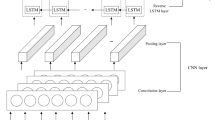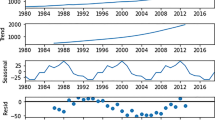Abstract
The number of police cases is related to various social factors, and the prediction of police situation has always been a research hotspot. This paper first analyzes the influential factors of the police situation analysis and carries on the correlation analysis. Then, by comparing five models include linear regression, time series model, back propagation neural network model optimized by simulated annealing algorithm, convolutional neural network, and time series combined with convolutional neural network, it is found that the experimental performance of time series combined with convolutional neural network model is the best. Therefore, this study found that the most suitable model to predict the number of police cases is the combination of MV and CNN.





Similar content being viewed by others
REFERENCES
Wang, Q., Jin, G., Zhao, X., Feng, Y., and Huang, J., CSAN: A neural network benchmark model for crime forecasting in spatio-temporal scale, Knowl.-Based Syst., 2020, vol. 189, p. 105120. https://doi.org/10.1016/j.knosys.2019.105120
Das, P., Das, A.K., Nayak, J., Pelusi, D., and Ding, W., Group incremental adaptive clustering based on neural network and rough set theory for crime report categorization, Neurocomputing, 2019, vol. 459, pp. 465–480. https://doi.org/10.1016/j.neucom.2019.10.109
Shukla, S., Jain, P.K., Babu, C.R., and Pamula, R., A multivariate regression model for identifying, analyzing and predicting crimes, Wireless Pers. Commun., 2020, vol. 113, pp. 2447–2461. https://doi.org/10.1007/s11277-020-07335-w
Ivaskevics, K. and Almond, L., Predicting the criminal record of Hungarian homicide offenders from crime scene behaviours, Psychol., Crime Law, 2020, vol. 26, no. 1, pp. 22–33. https://doi.org/10.1080/1068316X.2019.1611831
Wibowo, A.H. and Oesman, T.I., The comparative analysis on the accuracy of k-NN, Naive Bayes, and Decision Tree Algorithms in predicting crimes and criminal actions in Sleman Regency, J. Phys.: Conf. Ser., 2020, vol. 1450, p. 012076. https://doi.org/10.1088/1742-6596/1450/1/012076
Yoo, Y. and Wheeler, A.P., Using risk terrain modeling to predict homeless related crime in Los Angeles, California, Appl. Geogr., 2019, vol. 109, p. 102039. https://doi.org/10.1016/j.apgeog.2019.102039
Yuki, J.Q., Sakib, M.Q., Zamal, Z., Habibullah, K.M., and Das, A.K., Predicting crime using time and location data, Proc. 7th Int. Conf. on Computer and Communications Management, Bangkok, 2019, New York: Association for Computing Machinery, 2019, pp. 124–128. https://doi.org/10.1145/3348445.3348483
Li, Mao and Wei, Du, A method of crime rate forecast based on wavelet transform and neural network, Int. J. Embedded Syst., 2019, vol. 11, no. 6, pp. 731–737. https://doi.org/10.1504/IJES.2019.103990
Lops, Y., Choi, Y., Eslami, E., and Sayeed, A., Real-time 7-day forecast of pollen counts using a deep convolutional neural network, Neural Comput. Appl., 2020, vol. 32, pp. 11827–11836. https://doi.org/10.1007/s00521-019-04665-0
Sayeed, A., Choi, Y., Eslami, E., Lops, Y., Roy, A., and Jung, J., Using a deep convolutional neural network to predict, Neural Networks, 2017, vol. 121, pp. 396–408. https://doi.org/10.1016/j.neunet.2019.09.033
Shankar, V.V., Kumar, V., Devagade, U., Karanth, V., and Rohitaksha, K., Heart disease prediction using CNN algorithm, SN Comput. Sci., 2020, vol. 1, p. 170. https://doi.org/10.1007/s42979-020-0097-6
Qin, Y., Li, K., Liang, Z., Lee, B., Zhang, F., Gu, Y., Zhang, L., Wu, F., and Rodriguez, D., Hybrid forecasting model based on long short-term memory network and deep learning neural network for wind signal, Appl. Energy, 2019, vol. 236, pp. 262–272. https://doi.org/10.1016/j.apenergy.2018.11.063
Ji, L., Zou, Y., He, K., and Zhu, B., Carbon futures price forecasting based with ARIMA-CNN-LSTM model, Procedia Comput. Sci., 2019, vol. 162, pp. 33–38. https://doi.org/10.1016/j.procs.2019.11.254
Singh, P., Indian summer monsoon rainfall (ISMR) forecasting using time series data: A fuzzy-entropy-neuro based expert system, Geosci. Front., 2018, vol. 9, no. 4, pp. 1243–1257. https://doi.org/10.1016/j.gsf.2017.07.011
Singh, P., High-order fuzzy-neuro-entropy integration based expert system for time series forecasting, Neural Comput. Appl., 2017, vol. 28, pp. 3851–3868. https://doi.org/10.1007/s00521-016-2261-4
Singh, P., Rainfall and financial forecasting using fuzzy time series and neural networks based model, Int. J. Mach. Learn. Cybern., 2018, vol. 9, pp. 491–506. https://doi.org/10.1007/s13042-016-0548-5
Singh, P. and Borah, B., High-order fuzzy-neuro expert system for daily temperature forecasting, Knowl.-Based Syst., 2013, vol. 46, pp. 12–21. https://doi.org/10.1016/j.knosys.2013.01.030
Funding
This study is partially supported by the Fundamental Research Funds for the Central Universities, project no. LGYB202102.
Author information
Authors and Affiliations
Corresponding author
Ethics declarations
The authors declare that they have no conflicts of interest.
APPENDIX
APPENDIX
About this article
Cite this article
Qiu Mingyue, Xinmeng, W., Yubao, W. et al. The Forecast of the Number of Police Cases Based on Time Series and Convolutional Neural Network Model. Aut. Control Comp. Sci. 56, 230–238 (2022). https://doi.org/10.3103/S014641162203004X
Received:
Revised:
Accepted:
Published:
Issue Date:
DOI: https://doi.org/10.3103/S014641162203004X




